| Designation: | Type 77 |
 |
|---|---|---|
| Manufacturer: | NORINCO - China North Industries Group Corporation - CNGC | |
| Product type: | Armoured Vehicles | |
| Name: | Tracked armoured personnel carrier |
Based on Soviet BTR50.
- Type 77-1 entered service in the mid-1970s
- Type 77-2 entered service in the early 1980s, with several hundred vehicles still in service with the PLA marine corps
The Type 77-1 is a tracked amphibious armoured personnel/artillery carrier vehicle developed in the 1970s. Based on the hull design of the Type 63 amphibious tank, the Type 77-1 is mainly used for carrying troops, artillery guns and cargo in the river regions of south China, where the mobility of heavier tracked armoured vehicles is limited. The Type 77 is generally similar to the Russian BTR-50 in terms of layout and purposes, though the two vehicles share little in their designs.
Development of the Type 77 began in April 1965, with two prototypes rolled out in the same year. After some modifications, the vehicle received its design certificate in 1977 and was officially designated as Type 77-1. The Type 77-2 is an amphibious armoured personnel carrier (APC) derived from the Type 77-1. The project began in 1978 and the vehicle received its design certificate in 1980.
Meanwhile there are around 200~300 Type 77-2 APCs in service with the PLA Marine Corps. The vehicle is generally regarded outdated but still effective in modern amphibious warfare.
- Type 77-1 amphibious armoured personnel/artillery carrier
- Type 77-2 amphibious armoured personnel carrier (APC)
The Type 77-1 has an identical hull design as the Type 63 amphibious tank. It has a combat weight of 18 tonnes and carries 20 infantry troops, or 8 artillery crew plus an artillery gun and 20 rounds. Being fully amphibious, the vehicle has a two-man crew including a driver and a commander. Infantry passengers ride/dismount the vehicle through the roof and side hatches. A trim vane is mounted at the front of the hull for fording. The vehicle has no fire-fighting or NBC protection equipment.
The Type 77-1 has a single-piece driver's right-hinged hatch cover and three forward-facing periscopes, a single circular commander's hatch cover that opens to the rear and three forward observation periscopes, three hatches on the roof of the troop compartment for troop, cargo and artillery respectively, and a single forward-hinged door on the right side. Armour protection against 7.62mm caliber weapon systems is provided all round. There are four firing ports in the vehicle hull, two on each side of the vehicle.
One of the primary missions for the Type 77-1 is to carry a 85mm towed anti-tank cannon or a 120mm towed howitzer in the battlefield. The artillery is disassembled into several pieces when carried on the roof of the troop compartment. Hydraulic winch and ramps are provided on the vehicle to load/unload the artillery. The bench seat kits in the middle of the troop compartment can be folded down and stowed when not in use to make space for artillery pieces and artillery rounds.
The Type 77-2 is a dedicated amphibious personnel carrier, with all winches and ramps removed. It has a slightly higher troop compartment. Shooting ports on the right side of the hull are replaced by a larger forward-hinged hatch for riding/dismounting troops and stretchers.
Main armament on the Type 77-1/-2 is a roof-mounted 12.7mm antiaircraft machine gun (AAMG) with a basic load of 500 rounds. The machine gun is operated by the vehicle commander, who has no protection while firing the gun.
The Type 77 is powered by a 12150L-2 4-stroke, 12-cylinder, liquid-cooled diesel engine with a standard power of 298kW (400hp). The fuel capacity is 416l. The vehicle has 5 forward and 1 reverse gears, with mechanical gear box and torsion bar suspensions. Two water jets at the rear are used for propelling and turning in water.
|
||||||||||||||||||||||||||||
 |
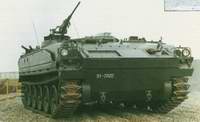 |
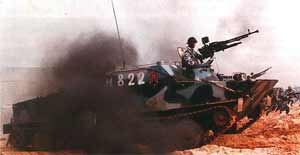 |
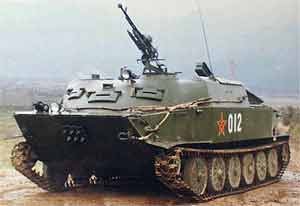 |
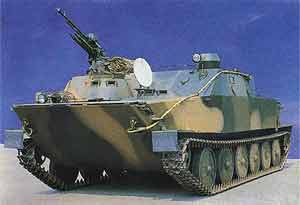 |
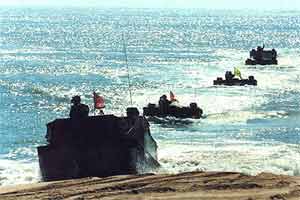 |
 |